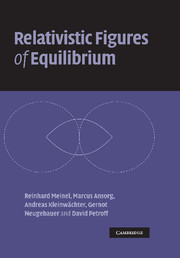Book contents
- Frontmatter
- Contents
- Preface
- Notation
- 1 Rotating fluid bodies in equilibrium: fundamental notions and equations
- 2 Analytical treatment of limiting cases
- 3 Numerical treatment of the general case
- 4 Remarks on stability and astrophysical relevance
- Appendix 1 A detailed look at the mass-shedding limit
- Appendix 2 Theta functions: definitions and relations
- Appendix 3 Multipole moments of the rotating disc of dust
- Appendix 4 The disc solution as a Bäcklund limit
- References
- Index
Appendix 4 - The disc solution as a Bäcklund limit
Published online by Cambridge University Press: 22 October 2009
- Frontmatter
- Contents
- Preface
- Notation
- 1 Rotating fluid bodies in equilibrium: fundamental notions and equations
- 2 Analytical treatment of limiting cases
- 3 Numerical treatment of the general case
- 4 Remarks on stability and astrophysical relevance
- Appendix 1 A detailed look at the mass-shedding limit
- Appendix 2 Theta functions: definitions and relations
- Appendix 3 Multipole moments of the rotating disc of dust
- Appendix 4 The disc solution as a Bäcklund limit
- References
- Index
Summary
In this appendix, we discuss an alternative representation of the solution for the rigidly rotating disc of dust. The underlying mathematical structure of this formulation is given through the so-called Bäcklund transformation, which is a technique that enables one to construct explicit solutions to the linear matrix problem (2.41) and the corresponding Ernst potentials f. These solutions take a particularly simple form, since they can be written as quotients of determinants in which only elementary functions and functions that can be calculated from a ‘seed solution’ f0 appear (see below for examples). The Kerr solution for a rotating black hole in vacuum, Equation (2.358), can be considered as a particular example of a Bäcklund transform, see e.g. Neugebauer (1980a). Moreover, the method allows for the construction of regular Ernst potentials, which correspond to disc-like sources of the gravitational field. In particular, it is possible to identify the rigidly rotating disc of dust as a well-defined limit of these solutions.
After the introduction of disc-like solutions, generated by Bäcklund transformations, depending on a set of parameters as well as a real analytic function, an appropriate generalization is given which allows the Ernst potentials to be written in terms of two free functions. For the rigidly rotating disc of dust, these functions take on a simple explicit form.
- Type
- Chapter
- Information
- Relativistic Figures of Equilibrium , pp. 203 - 207Publisher: Cambridge University PressPrint publication year: 2008



